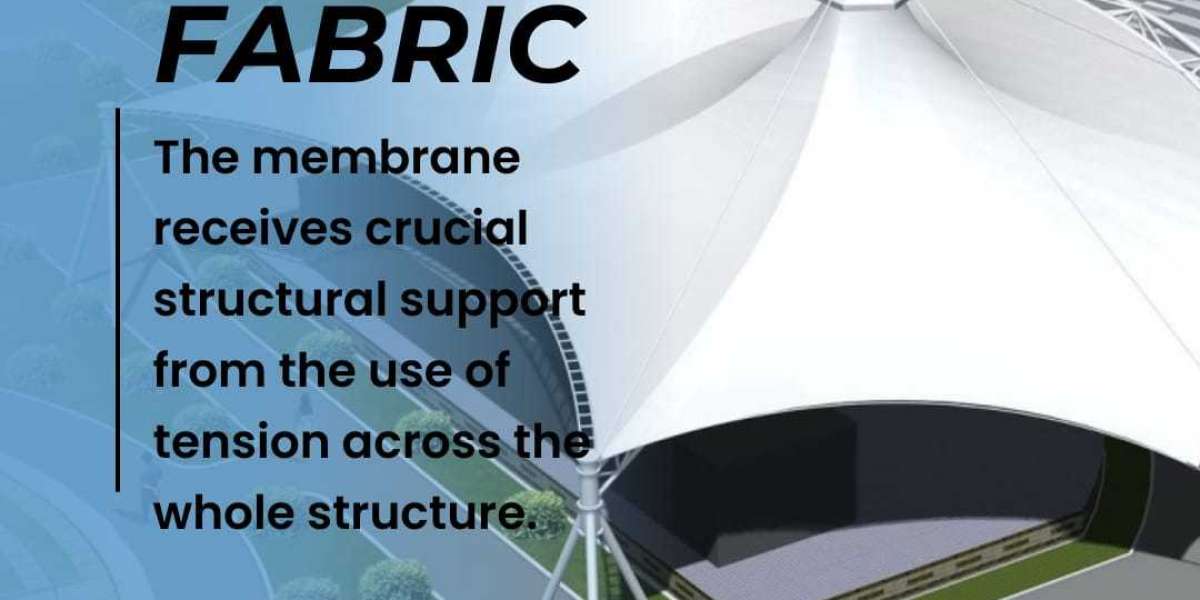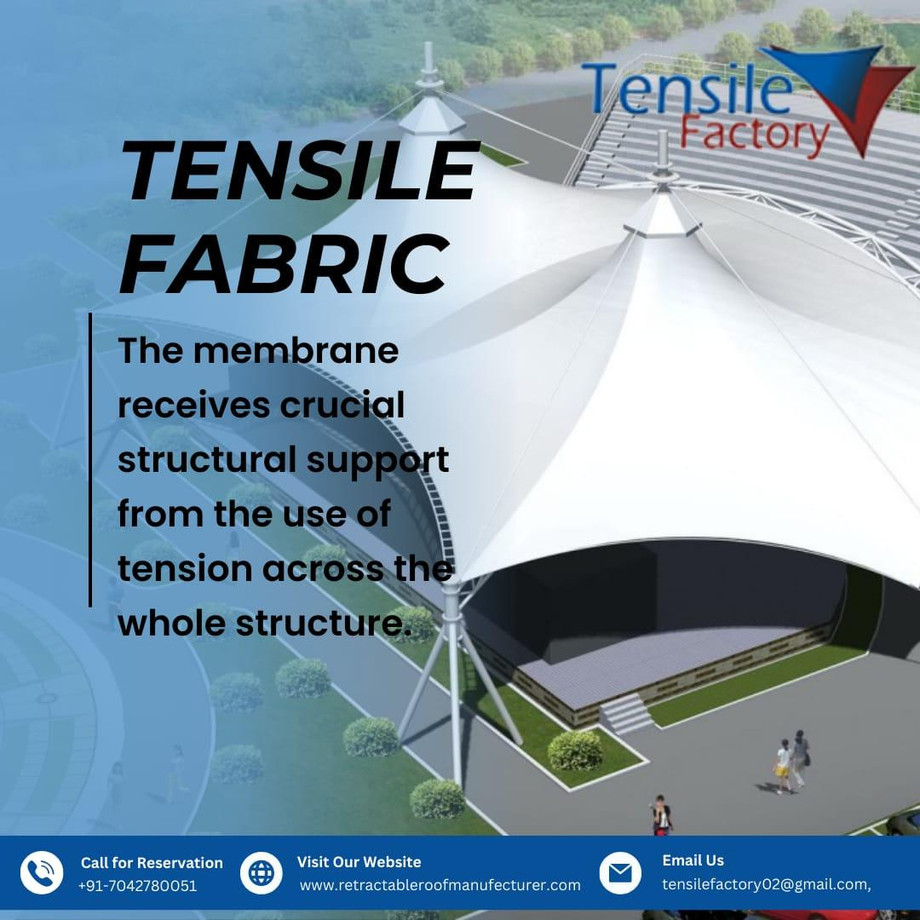Tensile Fabric: A Revolutionary Material for Architectural Innovation
Tensile fabric is revolutionizing modern architecture with its flexibility, durability, and aesthetic appeal. From stadiums and car parking structures to walkways and exhibition centers, tensile fabric structures provide a sustainable and cost-effective solution. This guide will explore everything about tensile fabric, its uses, advantages, and why it is the future of construction.
What is Tensile Fabric?
Tensile fabric is a high-strength, lightweight material used in the construction of tensioned membrane structures. These fabrics are designed to withstand extreme weather conditions while offering an innovative alternative to traditional building materials.
Key Features of Tensile Fabric:
- Durability: Resistant to UV rays, fire, and harsh weather.
- Flexibility: Can be molded into various shapes and sizes.
- Lightweight: Reduces structural load and foundation requirements.
- Eco-Friendly: Made from recyclable materials and reduces carbon footprint.
- Cost-Effective: Requires minimal maintenance and has a long lifespan.
Applications of Tensile Fabric
Tensile fabric is widely used across various industries due to its versatility and strength. Here are some common applications:
1. Car Parking Shades
Tensile fabric car parking shades protect vehicles from harsh sunlight and rain, providing a modern and aesthetic appeal to parking spaces.
2. Stadium Roofing
Major sports stadiums utilize tensile fabric for roofing solutions due to its ability to cover large areas while allowing natural light to pass through.
3. Walkways and Canopies
Providing weather protection for pedestrians, tensile fabric canopies are commonly found in public areas, malls, and hotels.
4. Event and Exhibition Tents
Tensile fabric structures are widely used in event spaces due to their quick installation and dismantling features.
5. Swimming Pool Covers
With excellent resistance to water and UV rays, tensile fabric is ideal for covering swimming pools and recreational spaces.
Types of Tensile Fabric Materials
Tensile fabric is available in various types, each offering unique properties. Some of the commonly used materials include:
1. PVC-Coated Polyester
- Cost-effective and commonly used in temporary structures.
- Good fire resistance and UV protection.
2. PTFE-Coated Fiberglass
- High durability and excellent resistance to extreme weather.
- Ideal for permanent structures like stadiums and airports.
3. ETFE Film
- Transparent and lightweight.
- Used in innovative architectural projects like the Eden Project in the UK.
4. Silicone-Coated Glass Fabric
- Offers excellent strength and flexibility.
- Suitable for high-end architectural applications.
Advantages of Using Tensile Fabric Structures
The increasing demand for tensile fabric structures is due to their numerous benefits:
1. Aesthetic Appeal
Tensile fabric provides modern, stylish, and futuristic designs that enhance the beauty of any space.
2. Cost Savings
With minimal material usage, reduced labor, and low maintenance costs, tensile fabric is an economical choice for construction projects.
3. Quick Installation
Unlike conventional buildings, tensile fabric structures can be installed rapidly, reducing project timelines.
4. Energy Efficiency
Due to its light-diffusing properties, tensile fabric helps in reducing energy consumption by allowing natural light while providing shade.
5. Sustainability
Most tensile fabric materials are recyclable, making them an eco-friendly choice for sustainable architecture.
How to Choose the Right Tensile Fabric?
Selecting the appropriate tensile fabric depends on several factors:
- Purpose: Identify the intended application (e.g., car parking, stadiums, canopies).
- Material Type: Choose the right material based on durability, flexibility, and weather resistance.
- Design Aesthetics: Consider the overall architectural appeal.
- Budget: Balance cost with quality for optimal results.
Installation Process of Tensile Fabric Structures
The installation of tensile fabric structures involves several crucial steps:
1. Design Planning
Engineers and architects collaborate to design the structure based on project requirements.
2. Material Selection
Choosing the right fabric material ensures durability and performance.
3. Fabrication
The tensile fabric is cut, welded, and reinforced as per the design.
4. Frame Installation
A strong frame, usually made of steel or aluminum, is erected to support the fabric.
5. Tensioning Finishing
The fabric is stretched and secured in place, ensuring proper tension for stability.
Maintenance Care of Tensile Fabric
Proper maintenance ensures the longevity of tensile fabric structures:
- Regular Cleaning: Prevents dirt accumulation and maintains aesthetics.
- Inspection: Checking for wear and tear enhances safety and durability.
- Repairs: Timely repairs prevent damage from worsening.
- Weatherproofing: Ensuring water drainage and UV protection extends lifespan.
Future Trends in Tensile Fabric Structures
The future of tensile fabric in construction looks promising with innovative advancements:
- Smart Fabrics: Integration of solar panels and self-cleaning coatings.
- Sustainable Solutions: Use of biodegradable and recyclable materials.
- Enhanced Durability: Research on stronger and more resilient fabric materials.
Conclusion
Tensile fabric has transformed modern architecture with its versatility, sustainability, and aesthetic appeal. Whether for car parking, stadiums, or exhibition tents, tensile fabric offers numerous benefits, making it an ideal choice for various applications.
If you are looking for high-quality tensile fabric solutions, visit Retractableroofmanufecturer.com to explore our wide range of products and services.
FAQs
1. What is the lifespan of tensile fabric?
Tensile fabric structures can last anywhere between 10 to 50 years, depending on the material and maintenance.
2. Can tensile fabric withstand harsh weather conditions?
Yes, tensile fabric is designed to resist UV rays, heavy rain, and strong winds.
3. Is tensile fabric fire-resistant?
Most tensile fabric materials come with fire-resistant coatings, making them safe for various applications.
4. How do I clean tensile fabric structures?
Regular cleaning with mild soap and water helps maintain its appearance and longevity.
5. Can I customize the design of a tensile fabric structure?
Yes, tensile fabric structures can be tailored to meet specific design and functional requirements.
For more information, contact us today and let us help you build the perfect tensile fabric solution!



